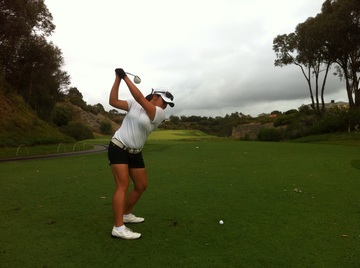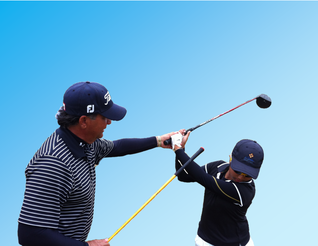"Every young successful golfer without exception has a long time coach/mentor that has helped guide them through the early developmental years and acts as a filter from the overload of information that is available out there".  Sounds like a simple question to answer. And for most people it'll be simply from the day the junior picks up a club, and will continue throughout his or her career. That is the formula for a lot of golfers who are continually changing swing patterns and never "own" their golf swings which keeps them in the "playing golf swing" mode instead of learning of "playing golf" mode and lowering their competitive score average. Last week my article touched on parents asking us how their can child emulate the young golf protege's like Rory McIIroy, Ryo Ishikawa, Matteo Manessero and the new young gun on the PGA Tour Jordan Spieth. One of the things that all of the young golfers mentioned above had were fully developed and established swing techniques by the time they reached their "specialization" years which is around 15 to 18 years old. I used the word protege above to describe the golfers I mentioned because the word is defined in the dictionary as "a person who is guided and supported by an older and more experienced or influential person". And this is true for every young successful golfer. Every young successful golfer without exception has a long time coach/mentor that has helped guide them through the early developmental years and acts as a filter from the overload of information that is available out there. They provide a long term development pathway for their young charges and understand and implement technical adjustments to a plan, and do not make swing changes because there is a flavor of the month technique being used by the current number one player! Rory McIlroy has been working with Michael Bannon for the last 14 years, and Jordan Spieth has been with his coach Cameron McCormick since he was 12 years old. Matteo worked with the Italian National Coach Alberto Binaghi most of his career.  Ryo has never worked with a professional coach however his father has filled that role admirably and has done a great job with his son on and off the golf course. Australian Jason Day has been with his long time coach/mentor/caddy Col Swatton since he attended both the Kooralbyn International School and the Hills High School golf program as an early teen, and where he met Col, who has been with him ever since. So all the above mentioned without exception had someone consistently guiding and developing their golf swing technique with a long term development plan. They end up with a fundamentally sound golf swing by their mid teenage years that they trust and that repeats under any situation - especially in competition conditions where the intensity level is highest. Let's get back to the "window" and form an understanding of the development time frame that allows the young golfer to reach a high level of competency in competition in their specialization years.  We classify the specialization years as ages 15 to 18 years old where they are competing in elite amateur tournaments and even professional events, and their competitive score average is around par. This is not a good time to be doing major swing pattern changes as the focus should be on scoring low. I am not advocating no swing work during this period but swing adjustment to improve solid contact, start line of ball and reduce curvature should be the goal. The first window is when a junior is introduced to the game between the ages 8 to 12 years old. Correctly fitted equipment is a must so that the basic fundamentals of grip, posture and alignment can be introduced. I don't mean just length and weight of club, but also the lie angle (irons), grip thickness and shaft flex are critical as equipment will influence motion (good or bad). In all my years of coaching juniors (over 40 years and for Lawrie 30 years) the number of times we have seen promising juniors in this age group go backwards when well meaning parents introduce a full size driver into the juniors bag to get more distance is countless. All it does is upset the dynamic balance in the swing resulting in tears normally. During this cycle (or period) after the setup fundamentals have been mastered, a sound bio-mechanical foundation is established encouraging proper sequencing of the body, arms and club. Getting the junior to not just perform the motion but also develop a good understanding of cause and effect by performing it correctly is very important. They should be given ample lead-up time to make the new movements and not do it whilst playing in tournaments. Most people understand this, but won't accept that it applies to them.  One of my junior golfers has developed a reverse pivot in her back-swing since I last saw her and has a big junior event next week. My advice to her and her parents is that she needs time over the next month to make the slight change to her spine angle to move it back to its original position. So the result is withdrawal from the tournament and time to focus and make the change over a month. She will test it out in club competitions during that period. During this cycle 70 percent of available time allotted to golf should be spent on technical improvement and 30 percent on playing holes. Jordan Spieth's coach when he started working with Jordan recognized instantly that his lower and upper body were working against each other so he got him started with just one drill to begin with and not try to change the whole swing. Jordan was very lucky that Australian PGA Trained Cameron McCormick understood the step by step golf swing change process required to make major swing changes. When Jordan started with his first drill, his first 50 practice balls were skulled (topped), chunked (fat) and not one shot got off the ground. But with the encouragement of McCormick (the North Texas PGA Teacher of the Year 2007 and PGA Teacher of the Year 2015) he made the changes necessary and went on to win two US Junior Championships. The only player to win more than one US Junior is a player named Tiger Woods.  So what can we learn from these young superstars? We learn that the window of time for them to establish technical mastery of their golf swing was between the ages of 12 and 15 years old. This is done with a coach who has a complete understanding of how to implement a step by step long term development pathway, and also is able to communicate this process to the young junior and also their parents. By doing this the junior and parents commit fully, and by the time he/she gets to the age of 15 years old (from a technical point of view) they are almost fully developed and ready to for the next cycle which is a competitive cycle. This is when Rory, Jason, Jordan, Ryo and Matteo were ready to compete at a very high level - even against professionals when they were given the opportunity. In conclusion, understand where the window of opportunity for swing change is and align the junior with someone who truly understands the long term development pathway and has a track record of implementing it successfully. David Milne and Lawrie Montague - Pro Tour Golf College The Professional Golf Tour Training College for Serious Amateur Golfers Comments are closed.
|
Archives
June 2019
|
Proudly Supported By
Copyright © 2011 - 2018 Pro Tour Golf College
Website Managed By Golf Performance Media
All Rights Reserved
Website Managed By Golf Performance Media
All Rights Reserved


 RSS Feed
RSS Feed



